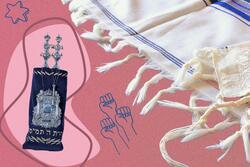Jewish Women Count: How B’midbar Taught Me to Be a Jewish Feminist
Counting should be easy. As young children, we start by learning how to count to five. Five fingers on each hand; five toes on each foot. Soon enough, we learn all the numbers up to 100. I see three apples, two brothers, one pencil. Pretty quickly, counting becomes kind of boring. Soon, we move onto more interesting endeavors. Perhaps we learn to add, or to multiply. Essentially, the significance of counting becomes lost, forgotten. Until my bat mitzvah, I too forgot about the true gravity of counting.
My bat mitzvah, on June 8, 2019, corresponded with the parasha of B’midbar, which details a census of the Israelites. In this specific census, 603,550 able-bodied male Israelites were counted. While there are other nuances to B’midbar, this census consumes the majority of the portion.
When tasked with writing a relevant D’var Torah speech, I initially found it difficult to draw meaning out of the numbers recorded in B’midbar. What could a census taken of male Israelites in the desert possibly teach me, a Jewish woman living in the U.S.? After many discussions of the portion, whether in my rabbi’s office or at the dinner table at home, I came to a crucial conclusion, which I shared in my D’var Torah:
“A census is not just a way of recording numbers. A census shows literally who gets counted but it also shows who counts in a more figurative sense. It shows who is important enough to be counted. A census is not just about the numeric value, it's also about the values of those administering the census.”
In the eyes of the Israelites hopelessly wandering the Sinai desert, able-bodied men “counted.” Men who could fight in an army were important enough to the community that they were recorded. Women and children were not.
By closely reading my parasha, my thirteen year old self rediscovered something: the power of counting. The men who were counted are immortalized, remembered each year by thousands of Jewish communities around the world. Their mothers, wives, and daughters are too easily forgotten.
I found myself angry that these women were blatantly disregarded. How could they want to be part of a faith so unfair, so unequal?
I learned from my Torah portion that I was part of that faith too.
Part of the second generation of women in my family to have a bat mitzvah, I had often taken for granted the privileges I received in my Jewish communities. At my synagogue in London, children were taught that men and women used to sit separately in our sanctuary. The key word, “used to,” signified that this separation was a thing of the past, that men and women praying together was the best way to achieve equality. Yet, the fact that I stood in front of my closest friends and family discussing a holy text that essentially claimed women “do not count” taught me to pay more attention to sexism within Judaism. I became a Jewish feminist.
As I reflect upon this transformation, I know now that the entirety of my education— both at school and out in the world—had led up to that moment. Throughout my life, I have been highly committed to fighting for equality between genders. This ingrained feminism came from an intentional upbringing. My parents gave me the Hebrew name Yocheved-Miriam after two powerful women in the Torah. Each Passover, a Miriam’s Cup has a place at our seder table along with Elijah’s. My all-girls education taught me that girls are just as intelligent and valuable as men. I looked up to the older girls at school, and listened each day as our principal swore that women were just better because “we, unlike puny men, can multi-task.”
However, my perspective on feminism as it pertains to Jewish practice is constantly evolving. This summer, I had the privilege of participating in a five-week trip to Israel. On the trip, we heard from women who preferred praying in separate spaces. To them, the sisterhood was more empowering than co-ed prayer.
While I expected modern Tel Aviv to be my favorite part of the country, I found more appreciation for the Kotel and Jerusalem’s Old City. My favorite Shabbat was the one we spent in Tzfat, at a separated synagogue. While I at first felt that the long skirt and modest shirt I wore were restrictive; I felt a sense of vulnerability, of nakedness when my shawl slipped off one shoulder. While I at first felt left out being unable to see the men on the other side of the mechitza, I felt a strong sense of sisterhood and connection as we American teens danced joyously with elderly Israeli women.
All my life, and especially since my bat mitzvah, I had felt that separated spaces should be left in the past, that forward-looking, feminist Judaism could never occur in a separated synagogue. My feelings this summer surprised me a great deal. While I’m still grateful I get to sit next to my brothers and father on Rosh Hashanah, I have a more open mind about other Jewish women’s practices. Each Jewish woman deserves to feel empowered in her own way; she deserves to know that she counts.
This piece was written as part of JWA’s Rising Voices Fellowship.







